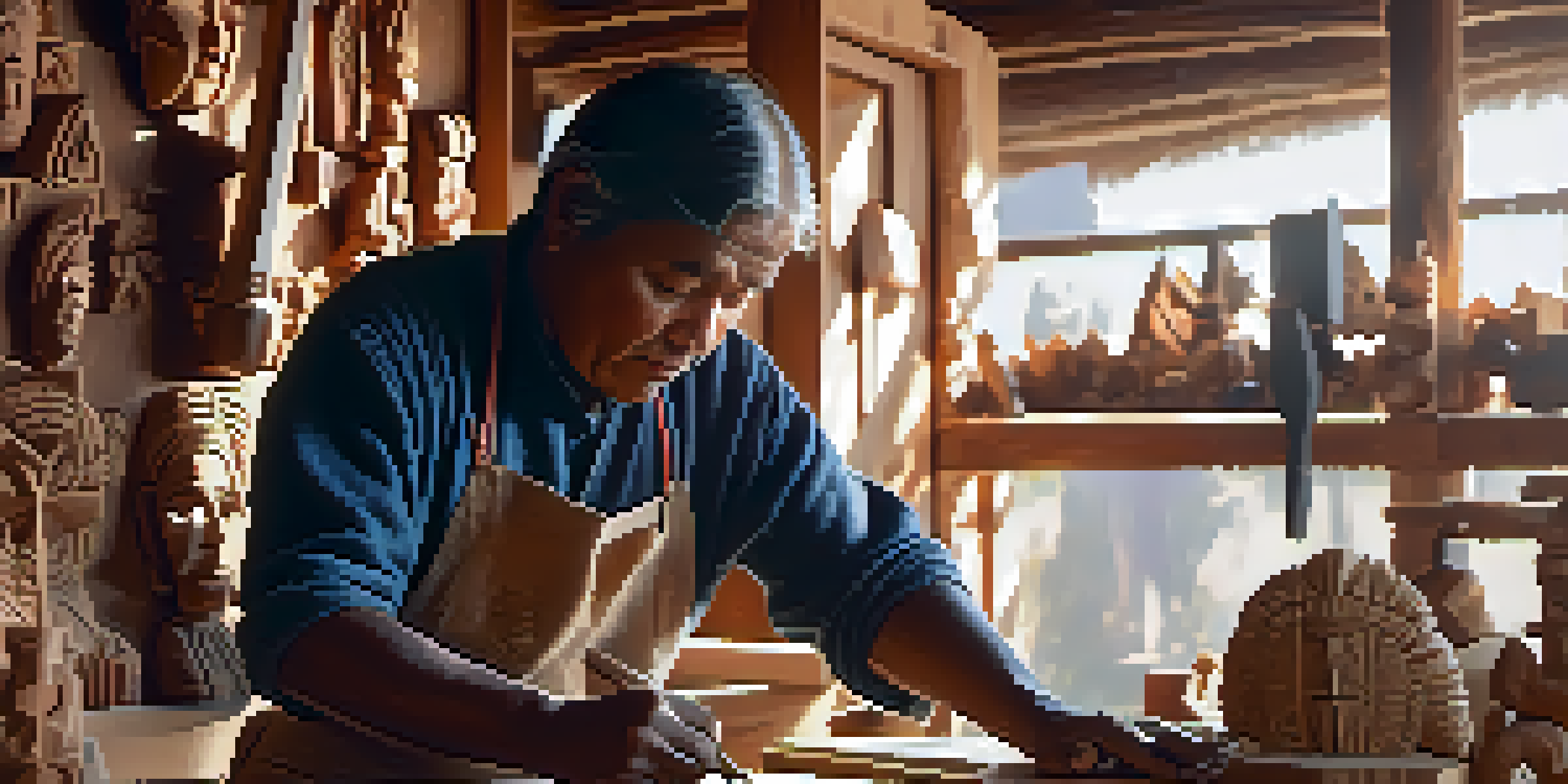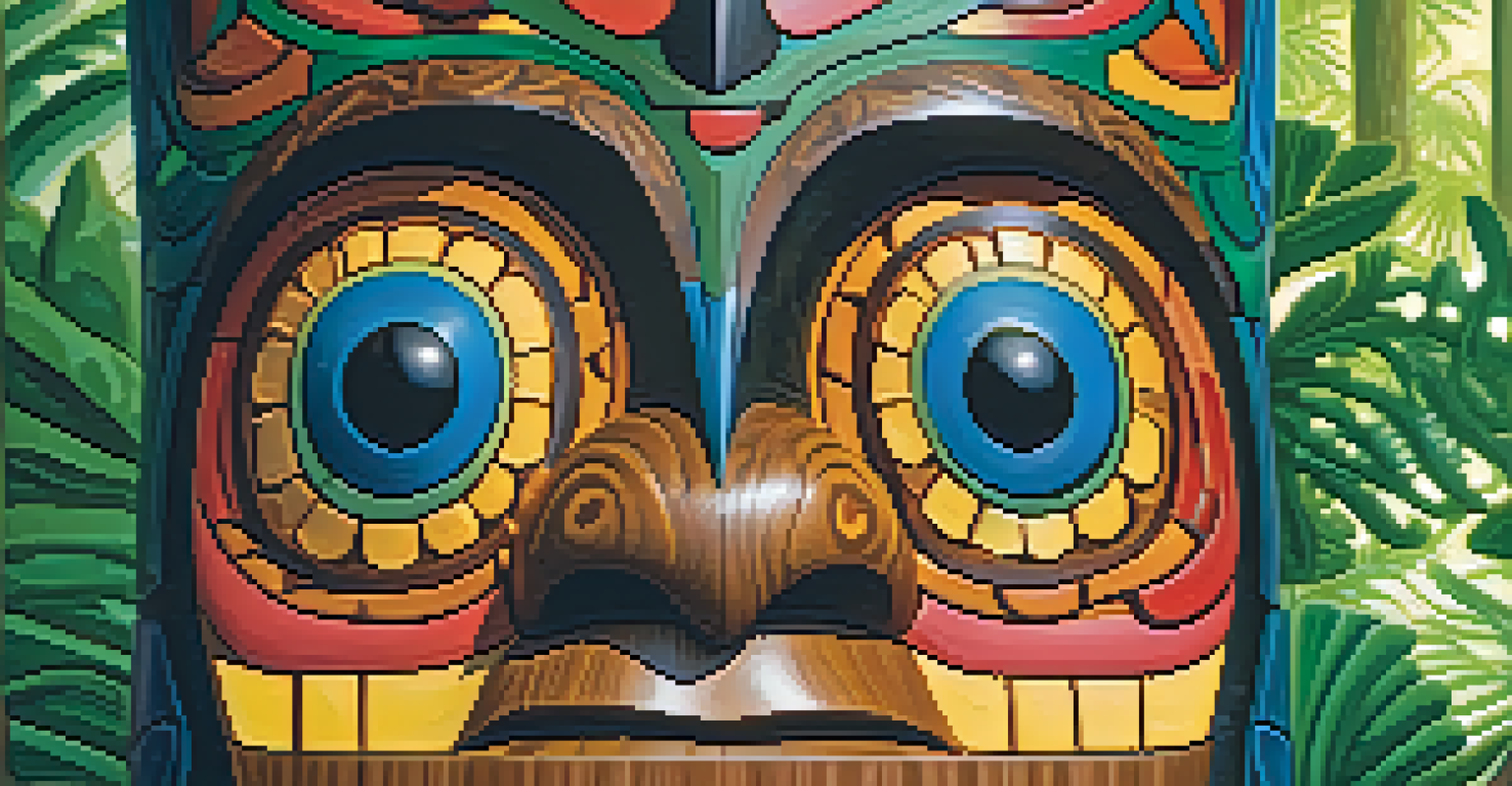Carving and Identity: Expressions of Indigenous Heritage

Understanding the Significance of Carving in Indigenous Cultures
Carving is more than just an art form; it's a vital expression of Indigenous identity. For many Indigenous communities, each carving tells a story, preserving ancestral knowledge and cultural beliefs. These intricate designs often represent symbols of nature, spirituality, and community, connecting the carver to their heritage.
Art is not what you see, but what you make others see.
Additionally, carving serves as a medium for sharing legends and traditions with younger generations. By engaging in this craft, artisans not only keep their cultural narratives alive but also instill pride and a sense of belonging among community members. This continuity is essential in a world where Indigenous identities face numerous challenges.
Moreover, as Indigenous artists gain recognition globally, their carvings are celebrated not just for their beauty but also for their deep cultural significance. These works invite viewers to appreciate the rich history and values embedded within each piece, fostering greater understanding and respect for Indigenous cultures.
The Role of Materials in Indigenous Carving Practices
The choice of materials in carving is deeply rooted in Indigenous traditions, often reflecting the natural resources available in their environment. For instance, wood, stone, and bone are commonly used, each offering unique textures and qualities that influence the final artwork. This connection to the land highlights the symbiotic relationship between Indigenous peoples and their surroundings.

Furthermore, the sourced materials often carry their own stories and significance. A carver may choose a specific type of wood based on its traditional uses or spiritual meaning, adding layers of depth to their work. This mindful selection process underscores the importance of sustainability and respect for nature in Indigenous cultures.
Carving Preserves Indigenous Heritage
Each carving serves as a vital expression of Indigenous identity, preserving ancestral knowledge and cultural beliefs.
As contemporary artists experiment with new materials, they still honor traditional practices, striking a balance between innovation and heritage. This evolution in technique not only enhances the artistry but also helps bridge the gap between past and present, inviting a broader audience to engage with Indigenous art.
Carving as a Means of Cultural Resistance and Revitalization
In the face of colonization and cultural erasure, carving has emerged as a powerful tool for cultural resistance among Indigenous communities. By reclaiming traditional carving techniques and reviving ancient stories, artists assert their identity and challenge dominant narratives. This act of creation serves as both a personal and collective form of empowerment.
The arts are not a luxury; they are a necessity for a healthy society.
Moreover, carving allows Indigenous peoples to celebrate their unique heritage in a contemporary context. Artisans often blend traditional styles with modern influences, creating pieces that resonate with both their community and a global audience. This fusion of old and new not only revitalizes cultural practices but also fosters dialogue about Indigenous issues today.
As these artworks gain visibility, they challenge stereotypes and misconceptions, encouraging appreciation for the complexity of Indigenous identity. Each carved piece becomes an ambassador of culture, inviting viewers to reflect on their own understanding of history and heritage.
The Intersection of Carving and Spirituality in Indigenous Beliefs
For many Indigenous cultures, carving is intrinsically linked to spirituality and the sacred. Each piece often reflects spiritual beliefs, serving as a conduit between the physical world and the spiritual realm. This connection imbues the artwork with profound meaning, making it a vital part of ceremonial practices and community rituals.
Carvings can represent deities, ancestors, or natural elements, embodying the spirit of the subjects they depict. This reverence for the spiritual world is evident in the care and intention that goes into each piece, as artisans seek to honor their beliefs through their craft. This practice fosters a deep sense of responsibility in the carver, as they understand the weight of their artistic choices.
Materials Reflect Cultural Values
The choice of carving materials highlights the connection between Indigenous peoples and their natural environment, emphasizing sustainability.
Furthermore, the act of carving itself can be seen as a meditative practice, allowing artisans to connect with their inner selves and the universe. This spiritual dimension not only enriches the artistic process but also reinforces the cultural significance of carving as a means of expressing faith and identity.
Community Engagement: Carving Workshops and Education
Carving workshops play a crucial role in preserving Indigenous heritage by engaging community members and fostering skill development. These sessions provide a platform for sharing knowledge between generations, allowing elders to pass down techniques and stories to younger artists. This hands-on approach nurtures a deep appreciation for the craft and its cultural significance.
Furthermore, these workshops often serve as a space for dialogue and connection, bringing together individuals from diverse backgrounds to learn about Indigenous cultures. Participants not only gain practical skills but also develop a greater understanding of the history and values embedded in carving. This exchange promotes respect and fosters lasting relationships within the community.
As more institutions recognize the importance of these educational initiatives, they contribute to the broader movement of cultural revitalization. By supporting Indigenous artisans and providing resources for workshops, organizations help ensure that carving remains a vibrant and evolving expression of identity.
The Influence of Technology on Contemporary Carving Practices
In recent years, technology has begun to influence traditional carving practices in remarkable ways. From digital design software to advanced tools, artisans are exploring new methods to enhance their craft while preserving traditional techniques. This melding of old and new opens up exciting possibilities for artistic expression and innovation.
For instance, some artists are now incorporating laser cutting and 3D printing into their work, allowing for intricate designs that were once challenging to achieve. These technological advancements can complement traditional methods, offering a unique blend that captures the essence of Indigenous heritage while appealing to modern aesthetics.
Carving as Cultural Resistance
Carving acts as a powerful tool for cultural resistance, allowing Indigenous artists to reclaim their identity and challenge dominant narratives.
However, this shift raises important questions about authenticity and cultural appropriation. It is crucial for artists to navigate this landscape thoughtfully, ensuring that their work remains rooted in their cultural identity while embracing new tools. By doing so, they can honor their heritage while pushing the boundaries of artistic expression.
Celebrating Indigenous Carving: Exhibitions and Global Influence
Exhibitions showcasing Indigenous carving have gained prominence, providing artists with platforms to share their work with a broader audience. These events not only celebrate the artistry of Indigenous cultures but also educate viewers about the rich histories and meanings behind each piece. Such visibility is essential in combating stereotypes and fostering respect for Indigenous identities.
Moreover, these exhibitions often feature collaborations between Indigenous artists and curators, ensuring that the narratives presented are authentic and representative. By centering Indigenous voices, these showcases invite conversations about cultural heritage, representation, and the ongoing challenges faced by Indigenous communities.

As more people engage with Indigenous art, the global influence of carving continues to grow. This increased appreciation not only validates the importance of these artistic expressions but also supports Indigenous artists in their efforts to preserve and innovate their cultural traditions.